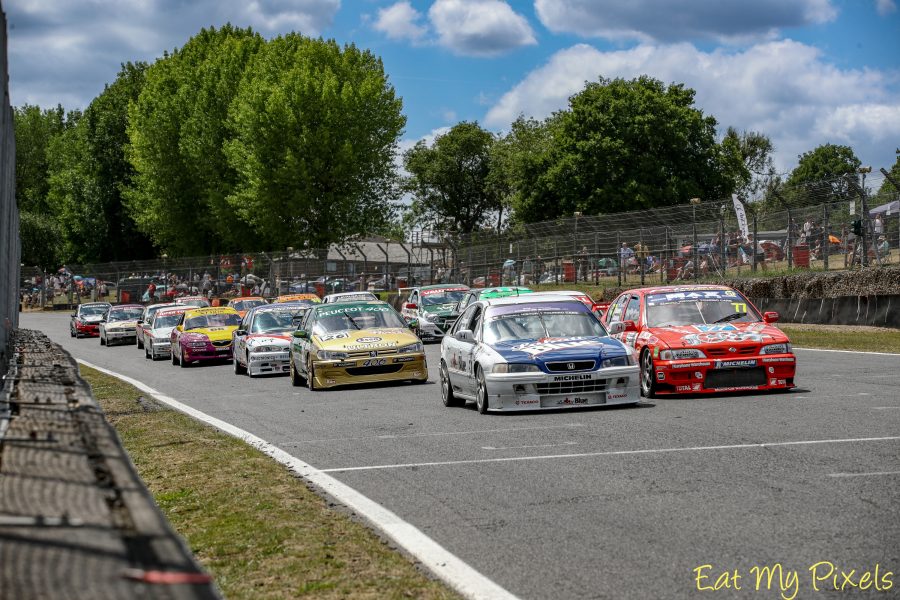The third edition of Super Touring Power was another glorious celebration of touring car racing through the ages held in scorching weather at Brands Hatch.
While four-time British Touring Car champion Colin Turkington starred in the headline races for Super Tourers, it was Michael Lyons and Jason Hughes (twice) and who did the winning in Honda and Vauxhall machinery.
Special races for Group A cars of the 1980s were another highlight, along with high-speed demonstrations of many more touring cars.
And the CTCRC’s regular drivers, who make up the backbone of its membership, played a major role in all 17 races across a busy weekend of action.
Super Tourers
The 20-car entry of Super Touring cars matched the category’s highest ever, although sadly AJ Owen’s Ford Mondeo was lost to clutch slave cylinder failure in Friday testing. Seven were shipped from overseas including six from New Zealand in another fantastic effort from our Kiwi friends.
Colin Turkington set the pace in Saturday qualifying on the Grand Prix circuit. Having never driven a Super Touring car before – after a suspension problem sidelined the car from Friday testing – Turkington put Jason Hughes’s 2000-spec Vauxhall Vectra on pole position by 1.6 seconds.
Second fastest was historics ace Michael Lyons aboard the 1996 ex-David Leslie Honda Accord of New Zealander Peter Sturgeon. Former V8 Supercar racer Kayne Scott completed a top three of STP debutants in Sturgeon’s second car, an ex-Matt Neal 1997 Nissan Primera.
Colin Sowter would join Scott on row two of the grid in his Peugeot 406, while Alex Morgan was quickest of the BTC Touring runners in his Vauxhall Astra Sport Hatch. A driveshaft problem caused him to pit after his one flying lap and then the Astra’s engine blew two holes in the block when he returned to the circuit to check the fix, leaving it a non-starter for the race.
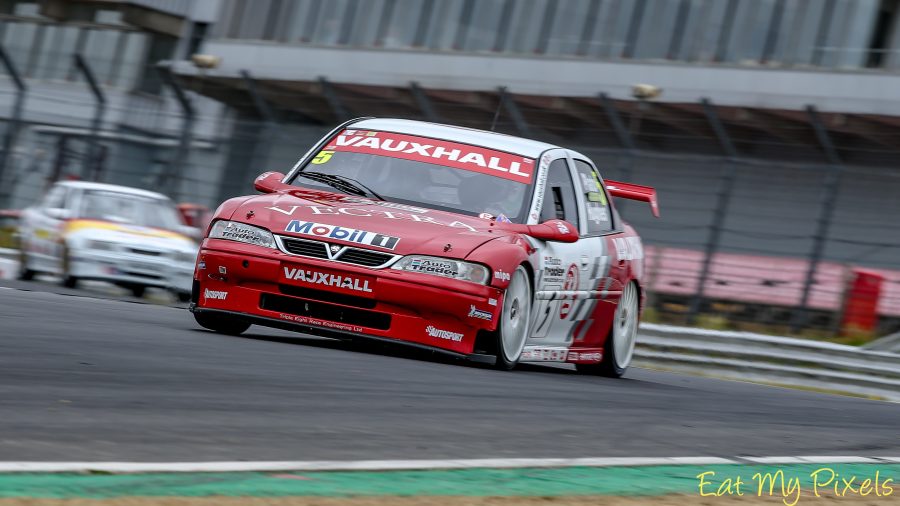
Hughes himself was sixth in his BTC-T MG ZS despite a misfire. The top eight was completed by Kiwi duo Conrad Timms (ex-Kelvin Burt Ford Mondeo) and Paul McCarthy in his glorious 1993 ex-Patrick Watts ‘rhubarb and custard’ Mazda Xedos 6, which was making its first return to this country in over 30 years.
Turkington and Lyons ran side by side through the opening corners of Saturday’s race before Lyons roared ahead into Graham Hill Bend. The Honda’s lead lasted barely half a lap though, as Turkington powered past on the Derek Minter Straight. Sowter jumped into third while McCarthy and Timms traded fourth as Scott headed to the pits as the Primera intermittently dropped into limp mode.
After brake failure in qualifying left him near the back of the grid, Rick Kerry’s BTC-T Peugeot 406 Coupe suffered a puncture which deposited him in the Clark Curve gravel at the end of the second lap. That brought out the safety car with leader Turkington separated from the pursuing Lyons by Scott’s now lapped Nissan.
Turkington streaked away at the restart and had built a lead of more than 10s when the Vectra’s front-right suspension failed at Graham Hill Bend on lap nine of 12. Lyons inherited a healthy advantage and duly took victory on his first race in the car.
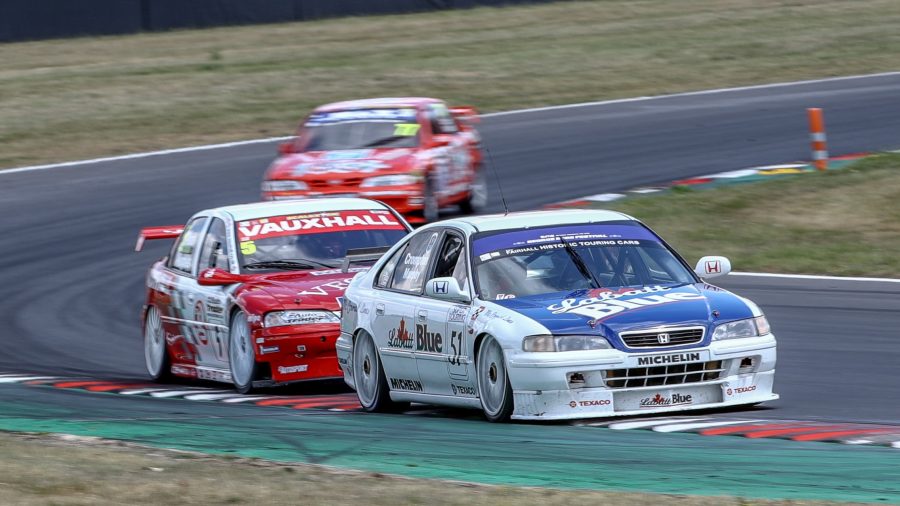
After a poor getaway, Timms picked his way back through the field. He overtook McCarthy after the restart, quickly latched onto Sowter before passing the Peugeot on lap eight, and inherited second place upon Turkington’s demise. “The harder you push, the more fun it becomes,” said a happy Kiwi, admitting he was still learning the challenging Grand Prix circuit.
Sowter finished third and McCarthy fourth, matching the Xedos’s best BTCC results in period. Benefiting from Matty Evans’s Vauxhall Cavalier blowing its engine, Rob Carvell finished fifth in Allan Scott’s Mazda 323F. Sixth was Jim Pocklington, his 1990 Vauxhall Cavalier being the oldest car on the grid.
Roger Stanford’s Astra was best of the BTC-T cars in seventh, just ahead of David Power’s Mondeo, after Hughes’s MG again hit trouble, a crankshaft sensor the suspected cause.
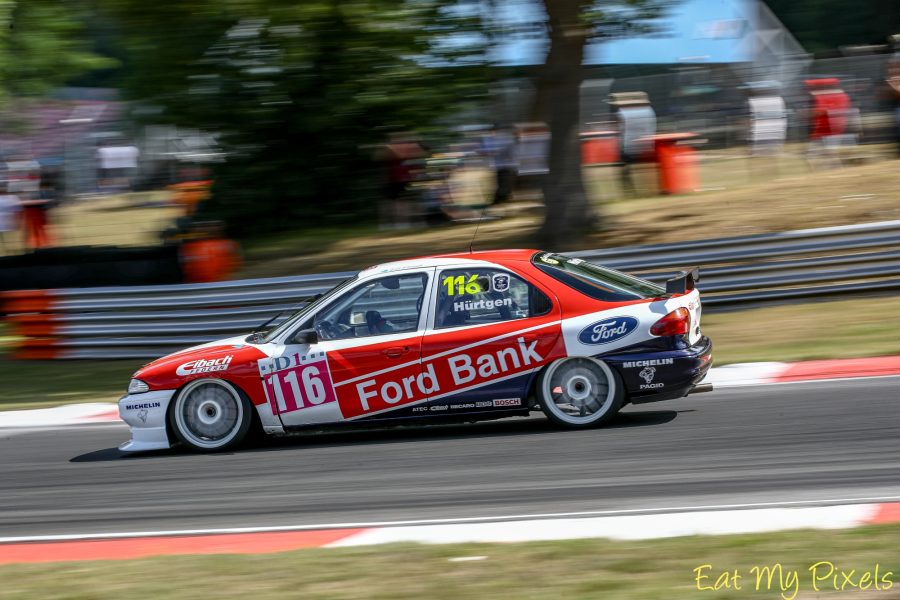
Sunday’s action switched to the spectator-friendly Indy circuit and it was Lyons who took pole, four tenths faster than Scott’s Primera. Sowter improved to third fastest, ahead of Turkington who had now swapped with Hughes to drive the MG. Timms was fifth quickest, with Hughes only sixth as the Vectra hit more suspension woe.
Joining the field after not running on Saturday – having been delayed in customs – Nigel Arkell was ninth fastest in his Accord, while Scott O’Donnell managed 11th in his ex-Claudia Hurtgen Mondeo.
Following a spectator grid walk, the first of two races on the Indy circuit produced more side-by-side action through the opening corners. After banging wing mirrors, Scott emerged in front but Lyons was back ahead before the end of the lap.
Man on the move was Jason Hughes. He quickly charged into third and then nosed his Vectra inside Scott’s Primera going up Hailwood Hill on lap three of 15. Scott held on but was powerless to stop Hughes thundering past on Brabham Straight after a safety-car period.
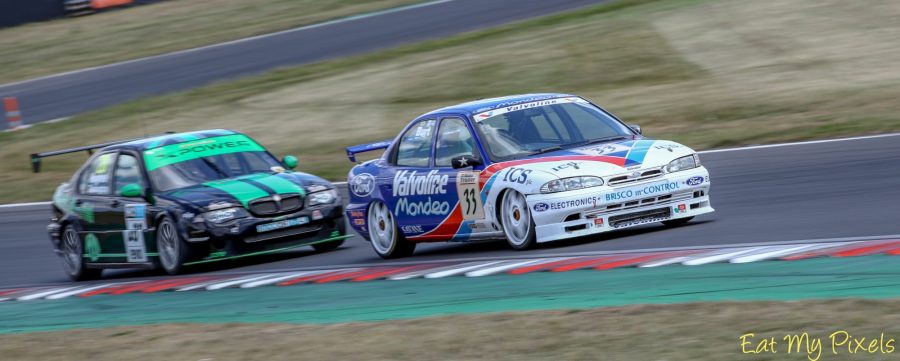
Hughes’s next target was race leader Lyons. He set the fastest lap as he closed in, bringing Scott with him for a while, before finally managing to squeeze inside at Clark Curve with three laps remaining. Lyons stayed with Hughes but was powerless to stop the 2023 champion taking his first win since that year’s season opener. “We had a good try,” he sighed.
“After all the hassle all weekend with both cars, it’s paid off,” said Hughes. “It was the widest Honda Accord I’ve ever known – fair play to him.”
Scott took a well-deserved podium finish, just 3s further back. “Any lap round here is petty special,” he admitted, having particularly enjoyed the previous day’s GP circuit action, “but the ones out the back – wow! That was something else.”
Timms just got better of Turkington for fourth after the pair traded the position on multiple occasions, and Sowter completed the top six ahead of Arkell, McCarthy, Pocklington and Kerry. O’Donnell’s Mondeo sadly succumbed to battery failure and would be a non-starter for the later race.
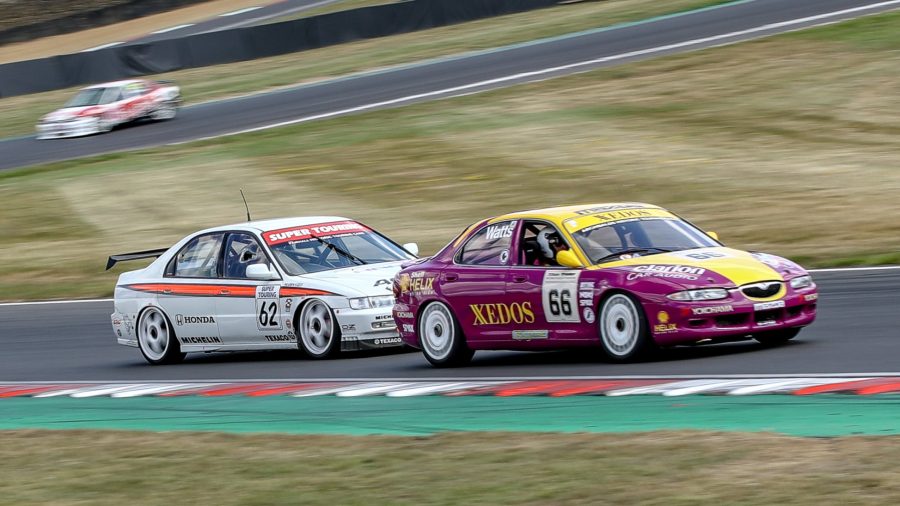
Starting from pole position, Hughes took a more straightforward victory in the weekend finale. Lyons kept him in sight but was unable to challenge, and also picked up some panel damage in traffic late on.
Scott’s woes returned on the Primera. Like O’Donnell, his battery was not providing enough voltage and kept causing him to slow. He initially ran third before slipping behind countryman Timms. Restored pace helped Scott back into third briefly but he eventually limped home fifth, behind both Timms and Turkington.
Arkell got the better of McCarthy for sixth, with Pocklington, Kerry and Stanford rounding out the top 10 to complete another weekend to remember.
Group A with Pre-’93 Touring Cars
Like last year, a grid of pukka Group A cars was assembled to run alongside the regular CTCRC Pre-’93 Touring Cars. Paul Mensley’s Ford Sierra RS500 was again the car to beat and the Leicestershire racer duly swept to a clean sweep of four victories across the weekend. Pre-’93 honours were split between Ian Bower (twice), Shaun Morris and Will Davison.
The 11-car entry of Group A machinery numbered seven RS500s, three BMW M3 E30s and a sole Rover Vitesse. Sadly, the Rover and one of the RS500s were delayed in customs and didn’t arrive until Saturday afternoon, although Allan Dippie did still manage to get his Vitesse on track later that day.
BTCC star Tom Ingram set the pace in qualifying at the wheel of Jeremy Sutton’s Tony Longhurst-tribute RS500 despite having first sampled the car (or any other Group A racer) only in Friday testing. Ingram was 0.4s quicker than Mensley.
Paddy Shovlin was next, bettering the sister M3 of his good friend and fellow former British GT race winner Michael Cullen. The RS500s of Mike Manning and Dan Brown would start together on row three, ahead of Jimmy Brodie (RS500) and former Lotus Cortina man Tim Abbott, debuting a glorious M3.
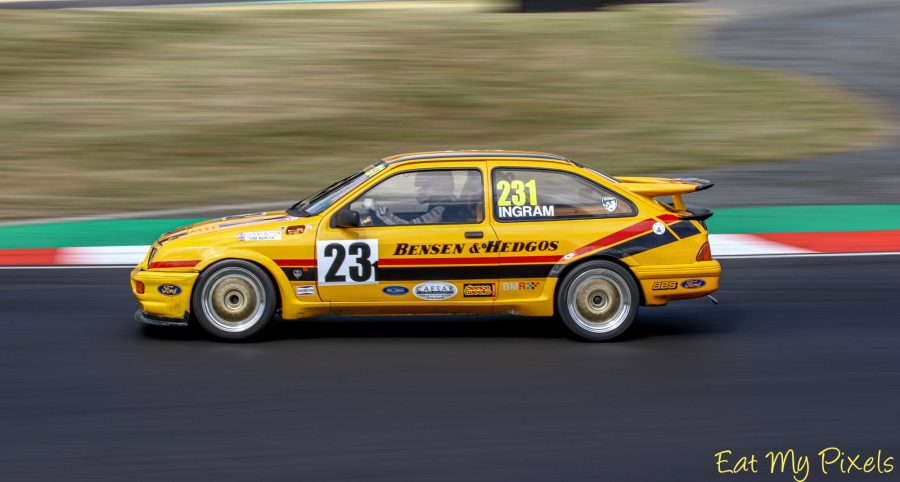
Bower was the best of the Pre-’93 men, ahead of Davison. Both broke into the top six overall but would start from a secondary grid, ahead of Oliver Owen and Kevin Willis.
While Ingram converted pole position into the race lead, a fast start from Cullen helped him alongside Mensley. The pair made relatively light contact and Mensley took a trip through the Paddock Hill gravel, while Brodie was also pitched onto the grass on the inside.
All that helped Ingram shoot into a lead of more than 5s within a lap, chased initially by Manning, with Mensley recovering to third ahead of Shovlin, Brown and Cullen.
But all was not well aboard the B&H Cossie. Fuel pressure problems began to slow Ingram from early on. Once Mensley had cleared Manning, he closed up to the leader, passing him under braking for Hawthorn around half-distance before Ingram toured in to retire.
Mensley charged to an untroubled win of more than 12s while Shovlin held off Cullen’s challenge for second. Hampered by overheating, Brown was some way back in fourth. Abbott was fifth and final Group A finisher in an attritional race, himself having survived an early tangle with the Pre-’93 leaders before tussling with Oliver Owen.
Manning and Brodie (engine) didn’t see the chequered flag, while Joey Binks’s Karl Jones tribute RS500 had already been sidelined by gearbox failure.
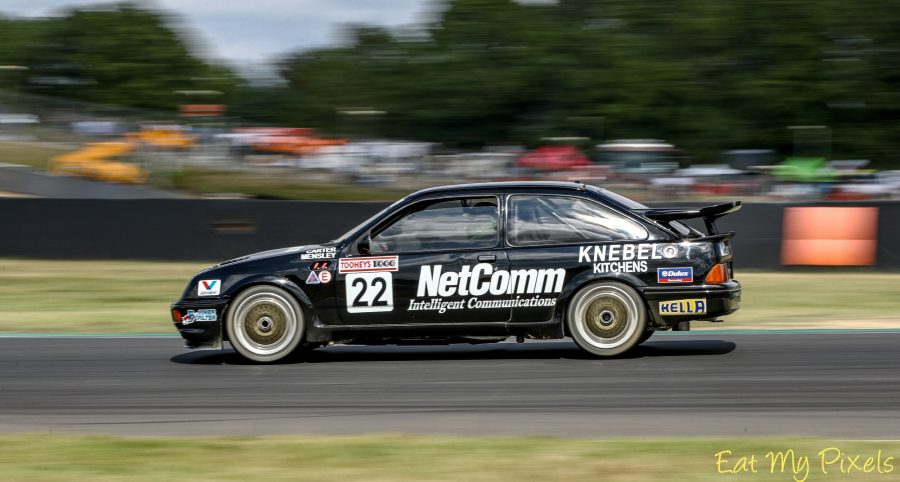
There may have been fewer cars, but the GP circuit rematch at the end of Saturday was a closer contest. Cooling issues alleviated, Brown pushed Mensley all the way and might even have snatched victory but for an early chequered flag due to circuit curfew.
Cullen was holding off Shovlin for third until tapped into a spin by Pre-’93 leader Bower at Druids. So it was Shovlin who completed the podium while Cullen still managed fourth in Group A. Jeremy Sutton got the B&H Sierra back on track and drove it to fifth in Group A.
Completing the runners, after Abbott’s early retirement, was Dippie’s sensational Rover. The Kiwi, making his Brands Hatch debut, had managed three green flag laps in separate races to qualify himself. He drove a steady race as he learnt the circuit in the 1986 TWR-built car which contested that year’s Spa 24 Hours in the hands of 1967 world champion Denny Hulme, Jeff Allam and Armin Hahne.
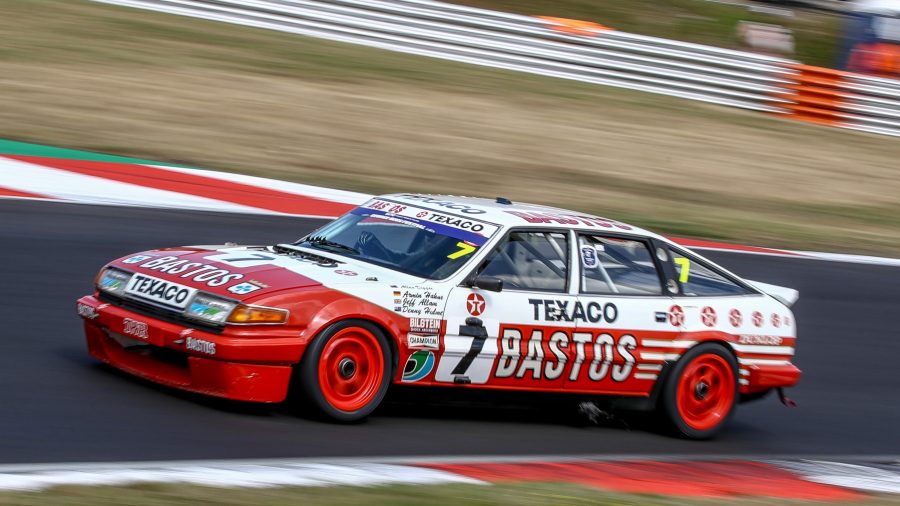
Switching to the shorter Indy circuit on Sunday, Scott O’Donnell boosted the depleted field with his late-arriving ex-Robb Gravett/Gianfranco Brancatelli Peanut Slab RS500.
Ingram was again quickest in qualifying despite completing only three laps due to propshaft failure. This time it was terminal and he was unable to start the race. The same fate befell Brown, whose RS500 broke a compression strut.
So it was Mensley and Shovlin who made up the revised front row, ahead of Cullen, O’Donnell and Dippie.
Mensley was largely untroubled en route to his third win of the weekend, despite a couple of hairy moments in traffic. “You can’t afford to lose any time and you don’t know how much they’ve seen the blue flags,” he admitted. “The M3s are better on the tyres and on the Indy circuit the Cossie really does eat the tyres.”
Shovlin and Cullen were quicker in the closing stages but also probably delayed each other with their tremendous tussle. They were separated by just 0.4s at the flag, 3s behind the winner, despite a last-lap moment for Cullen.
O’Donnell was fourth and Dippie fifth in Group A. The V8-powered Rover couldn’t keep up with the later Group A machinery, but instead enjoyed a good battle with the leading Pre-’93 cars.
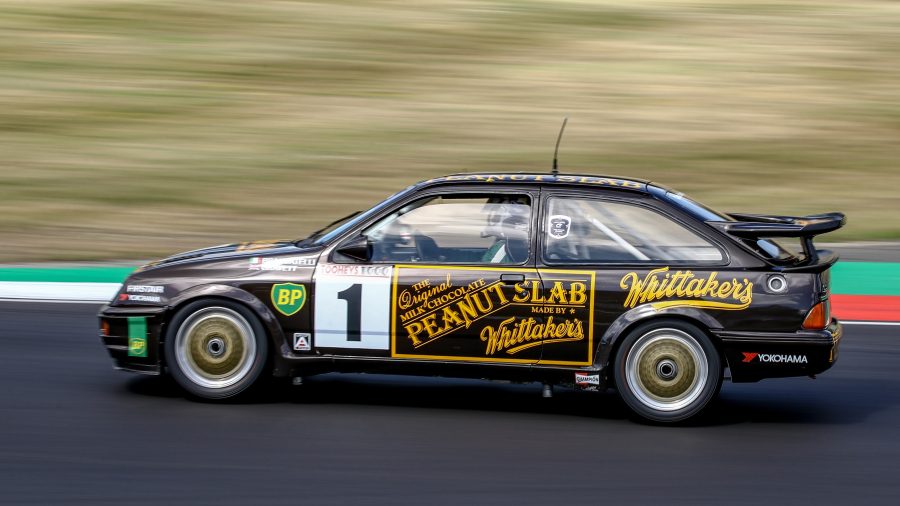
Shovlin was absent from race four after being involved in an accident in the preceding Pre-’66 contest. That left just four Group A cars running and Mensley decided he didn’t want to have things easy so dropped back at the start.
So it was another Australian-liveried RS500 that led the way in O’Donnell’s hands. Cullen then took over before Mensley picked his way through to complete his clean sweep in the car he describes driving as “a visceral experience”.
Cullen was 3s back in second as O’Donnell and Dippie dropped into the clutches of Pre-’93 cars. Those were led by Bower, who took his second win of the weekend. His championship rival Davison was second after shaking off the early attentions of Kevin Willis.
Bower had also won the opener after Davison’s race ended in the gravel at Stirlings after tangling with Abbott. A fire caused by his oil cooler being ripped off didn’t prevent Davison starting the second race and working his way forward from the back of a 37-car grid. Despite it being shortened to barely half its intended length, Davison managed to climb to fifth in Pre-’93.
He ended up only one place behind Bower who had been first in Pre-’93 on the road before being penalised for his incident with Michael Cullen. That handed victory to Shaun Morris – his first in Pre-’93 – ahead of Willis and Owen, the trio covered by just 0.6s.
Morris, who qualified third behind Davison and Bower in Sunday morning’s Indy circuit session, was an early casualty in race three when he went off at Paddock Hill Bend, effectively ending his weekend. Davison held off Bower to win by 0.4s, with Owen third after Willis was deemed to have overtaken before the control line after a safety car restart.
In his first appearance in the category this season, Byron Aldous took his Volkswagen Corrado to Class D honours in the opener before succumbing to power-steering failure in race two. That let in Mark Fynney for a triple success in his Vauxhall Astra GTE, back on track for the first time since its Silverstone smash in 2023.
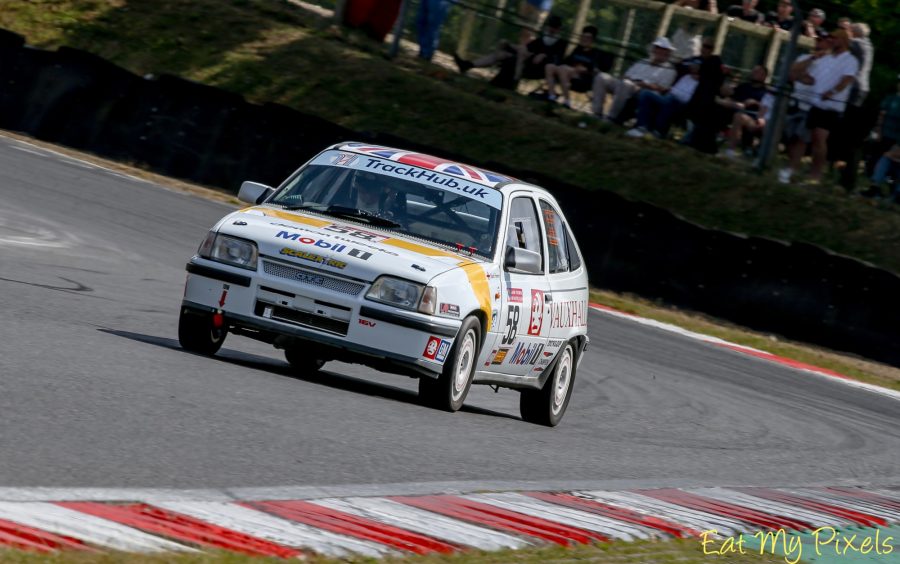
Pre-’03 Touring Cars

The Pre-’03 category shared a grid with the Pre-’03 and Group A cars, with a welcome increase in numbers. It was a successful first outing of the year for three-time champion Gary Prebble, who won both Grand Prix circuit races. On the Indy circuit, there were first wins for the BMWs of Dave Cave and John Hillyer.
Prebble’s K20-powered Honda Civic EG was well clear of next best Don Hughes (Peugeot 306 XSi) in qualifying and maintained his advantage in the first two races.
Instead, Prebble enjoyed battling with the powerful BMW M3s in Pre-’93. Even among those, only Ian Bower was able to beat him, and Prebble even defeated Bower in race two after the Pre-’93 driver was penalised.
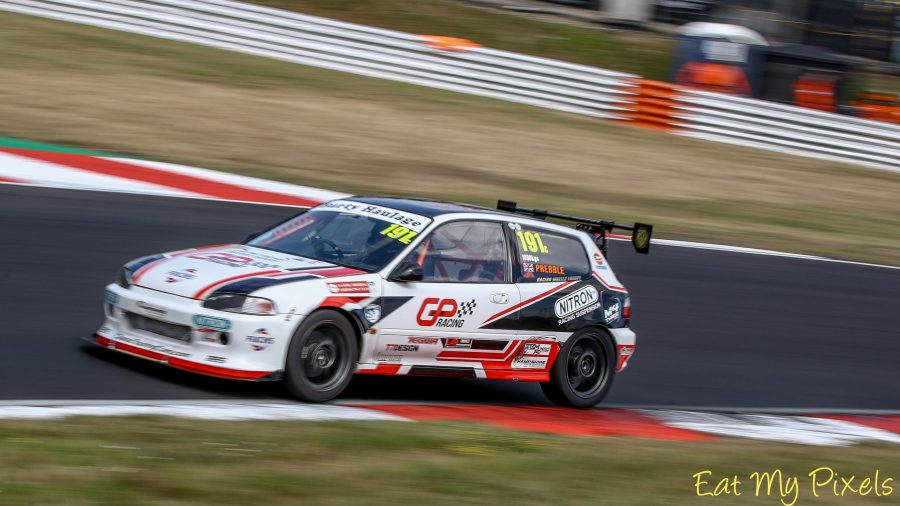
Hughes was a clear second in both Saturday races, with Brands Hatch local Kam Tunio completing the podium in his Honda Civic EP3.
The BMWs in Class A were topped by Hillyer’s E36 Touring in the first race, after his closest rival Cave suffered clutch failure on his 328 E36. Hillyer’s own retirement from the sequel opened the door for Simon Mann (328 E46) to take the honours.
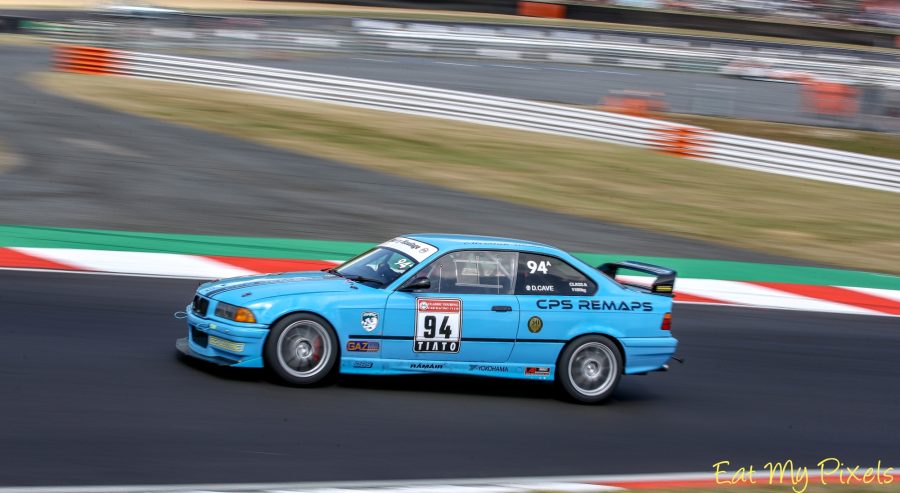
Prebble was fastest in qualifying on the Indy circuit too but clutch failure prevented him starting the races. Second-fastest qualifier Hughes was also a non-starter, let down by the Peugeot’s gearbox.
But Cave had commendably managed to repair his car overnight. Fifth fastest in qualifying, he was just 0.067s slower than third-quickest Tunio, with Hillyer splitting the pair and Adam Read’s BMW Compact only another tenth further back in an incredibly closely-matched bunch.
A quick start put Cave second behind Tunio, and he and Hillyer managed to overtake the Honda mid-race. Cave held off Hillyer to take his maiden win in Pre-’03 by just 0.7s as Tunio also slipped behind Read to a class-winning fourth.
Hillyer got the jump in the finale and withstood race-long pressure from Cave for his own first victory. Cave slowed on the final lap but still finished second. Tunio again took the laurels in Class C, this time beating Read to third overall in Pre-’03.

Though they weren’t able to match the pace of their rivals on their first visit to Brands, special mention must go to the mother-and-son pairing of Susanne Karlsson and Jimmy Pettersson who travelled from Sweden for the event.
Their Volvo V70 was particularly appropriate for an event celebrating 1990s touring cars and Pettersson, who built the car himself, had even installed an 850 front end for the occasion.
There were in fact three estates on the grid, as Pettersson/Karlsson joined regular Hillyer and another CTCRC debutant in form of Autoreserve’s Mark Bennett in his new-for-2025 Jaguar X-type. Bennett twice took fourth in class on Sunday.
Classic Thunder & Historic Thunder
Four close contests in Classic Thunder provided some of the best racing of the weekend as cars of vastly differing strengths fought out the honours. Ultimately, the BMW of Adrian Bradley and Alex Sidwell’s Holden split the wins, while V8-powered Andy Robinson and Abbie Eaton also starred.
A safety car and red flag in Grand Prix circuit qualifying meant drivers had no more than two laps to set a quick time. Those who were ‘on it’ immediately were rewarded, with three-time champion Andy Robinson snaring pole position in his Ford Falcon. Mike Cutt’s BMW M3 E36 was next quickest in Thunder as three BOSS runners broke into the top five overall.
Rikki Cann’s Historic Aston Martin V8 Vantage was next, ahead of Bradley (BMW M3 E46), Sidwell (Holden Commodore VF) and Colin Voyce’s Historic Ford Escort Mk1.
New slick tyres for the race aided Robinson in his quest for a first overall Thunder victory in five years. He led nearly 90% of the race distance but sadly it wasn’t to be for the jovial Northumberland-based racer.
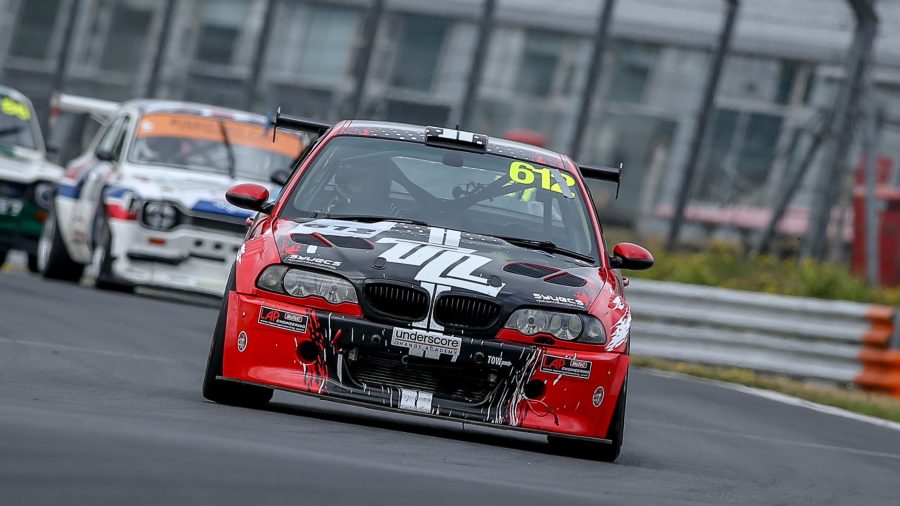
Both Bradley and Sidwell were on a charge from row four. Bradley demoted Cutt from third on the road (second in Thunder) into Hawthorn on lap three of 10 and had closed up to the leading pair of Robinson and BOSS man Piers Grange by the end of the lap.
As Grange was forced to focus on Bradley, Robinson made his escape. But Bradley snatched second at Sheene Curve mid-race and then closed up to the leader, passing him on the penultimate tour.
As Bradley charged to victory – perhaps surprisingly, his first overall in Thunder – Robinson now had Sidwell looming in his mirrors. The Holden made its move at Surtees on the final lap where, with the Falcon’s rear-left unloaded, light contact pitched it into a spin. Sidwell was through for second, with Abbie Eaton following and Robinson slipping to fifth in Thunder behind Cutt.
“The power of them other cars on the straights is just ridiculous!” said the wide-eyed winner, while Sidwell held his hands up to the last-lap contact. “I feel like I cheated Andy,” he rued. “I’ve raced with Andy for years – he knows I’m not a dirty driver.”
On his first appearance since this meeting last year, Simon Light’s V8-powered Ford Capri was the second Historic Thunder car home, while Cann just pipped Voyce to third in Historic Thunder.
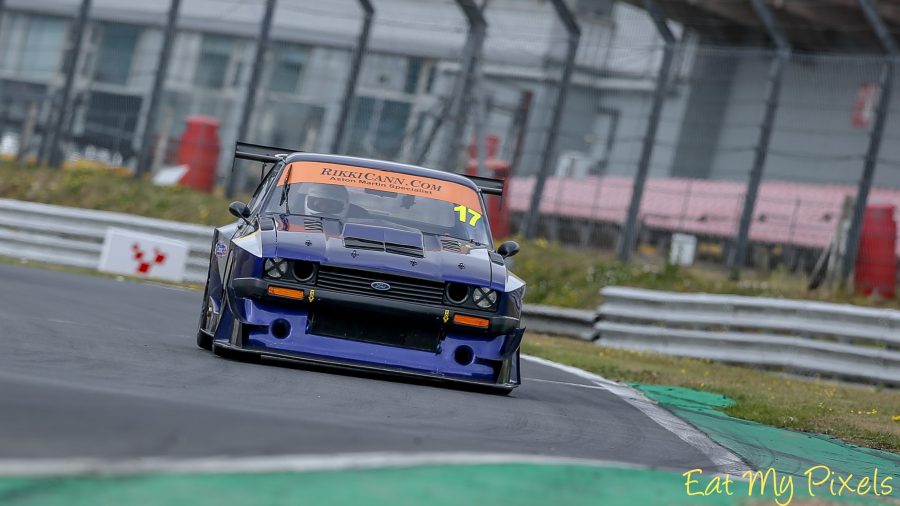
The afternoon’s rematch brought the leading contenders together at the front of the grid, but sadly a first-lap tangle exiting Graham Hill Bend left several cars with damage including Cutt, who soldiered on, and Voyce, whose weekend was run.
Bradley led the way as Eaton – having her best run yet in dad Paul’s venerable machine – jumped Sidwell and began to exert pressure on the BMW. The three ran together for most of the race, Eaton unable to make a move for the lead stick before Sidwell demoted her mid-race.
On the penultimate lap of a shortened race (due to timetable constraints), Sidwell got caught out at Clearways and tagged the back of Bradley’s Beemer. It was just enough for the rear wheel arch to start fouling the tyre and Bradley slowed to retire.
Sidwell continued to win, just a second clear of Historic winner Eaton, with Robinson some way back in third. Light and Cann made it three Historic cars in Thunder’s top five as Cutt still managed a class-winning sixth.
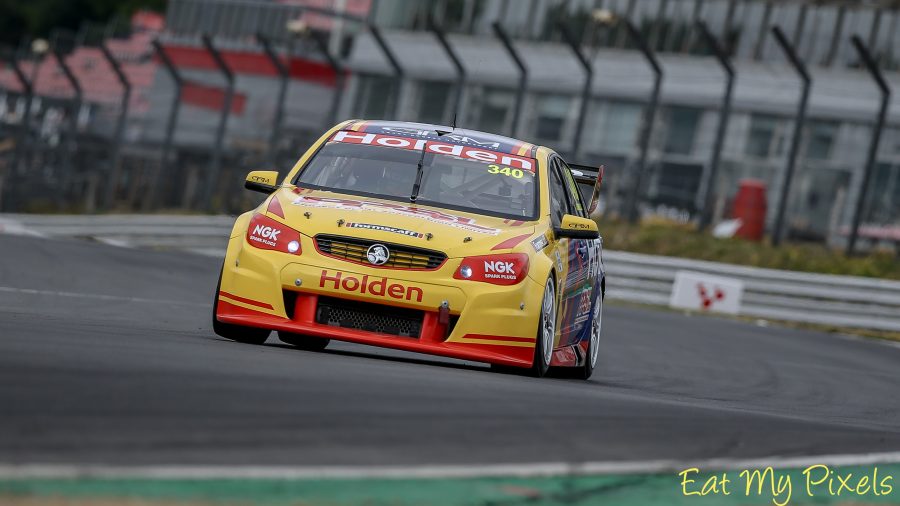
Switching to the Indy circuit on Sunday might have shifted the balance of power, particularly for the big Australian V8s. But in fact, they remained just as competitive as Bradley snatched pole by the tiniest margin of 0.007s over Sidwell. Robinson and Eaton qualified on row two although Robinson would start from the pitlane after last-minute drama delayed his arrival to assembly.
The two Holdens surged ahead of Bradley at the start and, after 15 minutes of seemingly relentless traffic to deal with – 30 cars on the 1.2-mile Indy circuit ensures things are always busy – they remained in that order. Sidwell won from Eaton and Bradley.
Cutt was fourth, with guest driver David Avis (E46) having an improved run to fifth in Thunder ahead of James Janicki in his Nissan Skyline. With Light sidelined by suspension failure in qualifying, Cann had an easier run to seventh (second in Historic) Thunder, just ahead of Robinson.
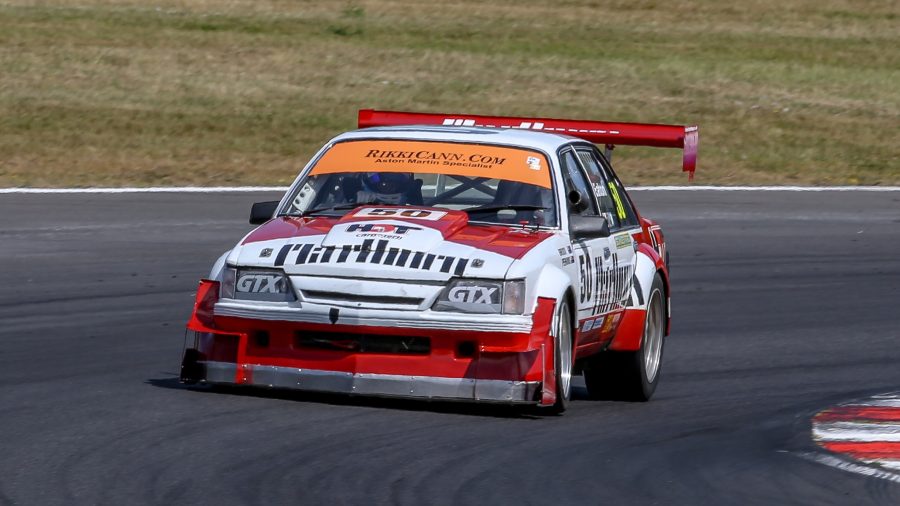
It was a similar story out front in the finale. Eaton harried Sidwell throughout. Sensing an opportunity as they negotiated traffic in the closing stages, she got a better line through Surtees and McLaren, nosing inside at Clearways. But as Sidwell turned in, there was contact and both cars ended in the gravel.
Red flags came out and Bradley inherited his second win of the weekend. In the absence of Cutt and Robinson, Avis and Janicki filled the rest of the podium positions while Cann won Historic Thunder in fourth overall.
Among the classes, Ian Bower (M3 E36) was unbeaten in Class C all weekend to strengthen his championship challenge. Ross Craig (Honda Civic EP3) did likewise in Class D, albeit with a lack of opposition.
Luke Bennett’s spaceframe SHP Eurocar V8 got the better of Jon Gill’s Vauxhall-powered Peugeot 205 in the first three races. More suited to the Indy circuit, Gill might have taken the third race but for a spin at Druids. Having been smoking heavily by the end of the race three, the Eurocar didn’t start the finale – although with Bennett a guest entry, it was Gill who took the points in all four races anyway.
Blue Oval Saloon Series

An improved entry of Fords shared the track with Classic & Historic Thunder. Piers Grange was the man to beat in his Smith & Jones-powered Escort Mk2, winning the first three races before AJ Owen took his dad Craig’s Sierra Cosworth to victory in the finale.
It was Owen who set the pace in the truncated qualifying session with Grange and Malcolm Harding’s similar Group 2-style Escort not far behind. Owen was fighting a losing battle with temperatures in the race though and slipped backwards. As Grange battled with the leading Thunder runners, he won BOSS by some 30s from Harding, despite a late trip through the Paddock Hill gravel.
Harding’s car expired late on in the second GP circuit race, Grange again winning comfortably from Owen (third in the opener).
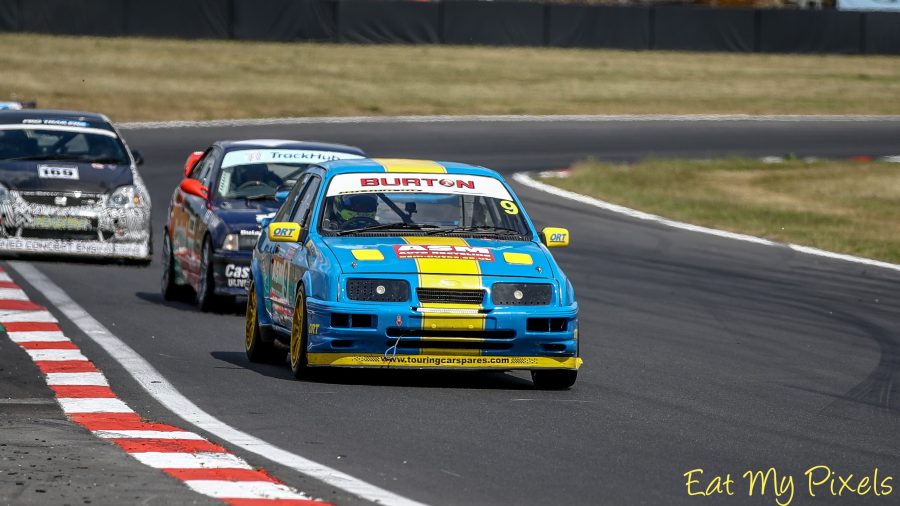
On the Indy circuit, Grange remained in a class of his own, as Martin Reynolds stepped into Harding’s role of next best in his own Group 2 Escort Mk2. With Grange a non-starter in the finale, Owen got the better of Reynolds to take BOSS honours.
Among the cars running on treaded rubber, Cliff Pellin’s Mk7 Fiesta ST180 edged the V8-powered brute force of Alan Breck’s Capri in the opener. Overheating sidelined Breck from race two, as local man Rod Birley (piloting Ralph Higman’s Ford Focus for the weekend) beat Pellin. Breck headed Birley in both Indy circuit races.
Tim Mizen was unbeaten in Class D as Pellin and Sam Daffin (Mk5 Fiesta) split the Class C honours, all three keeping their championship points tallies ticking over nicely.

Pre-’66 Touring Cars

The oldest cars on show also mustered the largest entry of the weekend, with nearly 40 cars in action including several guest runners. Former British Touring Car star Sam Tordoff reprised his role from last year’s non-championship event at Croft as he went unbeaten all weekend, this time piloting his new-for-2025 Ford Mustang.
Tordoff put the Jordan Racing Team-prepared Mustang – powered by exactly the same V8 that was in his Falcon last year – on pole by almost 2s on the Grand Prix circuit. His JRT team-mates Victor Cullen and Paddy Shovlin were next, both at the wheel of Lotus Cortinas, ahead of leading regular Piers Grange (Mustang).
Reigning champion Ian Thompson (Cortina) and returnee Joe Ferguson (Mini) would start on row three, ahead of Mini specialists Aaron Smith and Jo Polley.
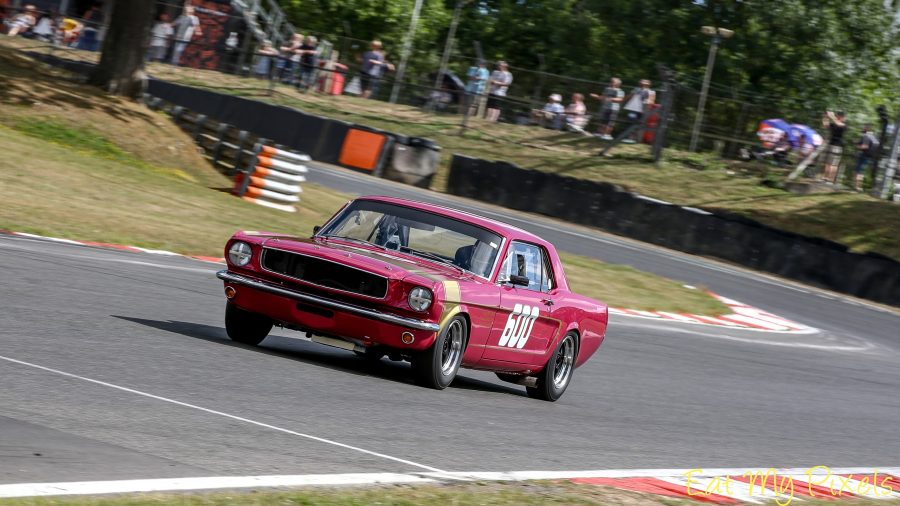
Although he had to manage the Mustang’s temperatures in the searing heat, Tordoff was otherwise untroubled en route to two dominant wins on the GP circuit. Cullen and Shovlin put on a show as they battled hell-for-leather for the remaining podium places, youngster Cullen getting the better of former British GT race winner Shovlin in both races.
A quick-starting Ferguson had got involved with the pair in the opener but ultimately had to settle for a class-winning fourth, still very impressive given the depth and quality of the Mini entry. He handed the car over to Tom Bell for race two, meaning Bell would have to work his way through from the back. Managing eighth overall and third Mini was a stellar effort.
Grange had also beaten Shovlin off the line in race one before slipping to fifth as his Mustang wilted. Smith, Polley and Thompson were next, with the returning Alan Greenhalgh (Ford Falcon) and Dan Wheeler (Mini) completing the top 10. But for Bell replacing Ferguson, their order was almost unchanged in the sequel.
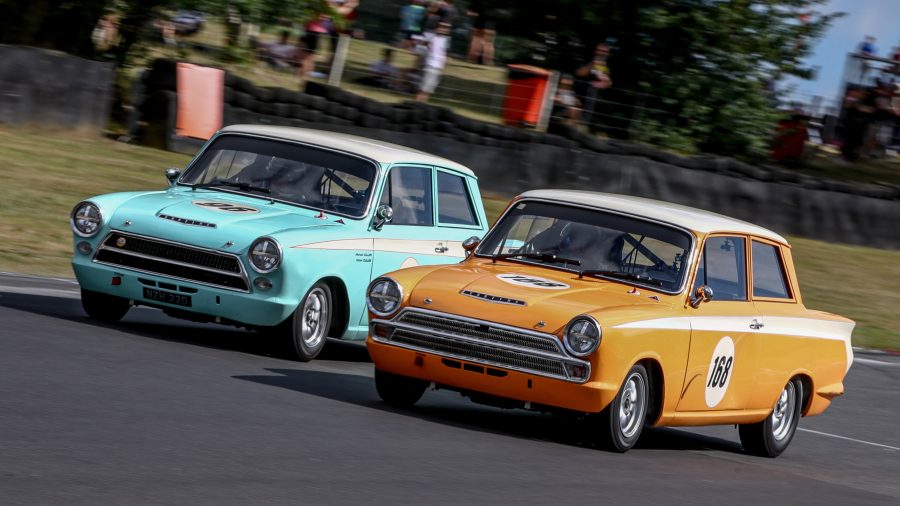
Tordoff stormed to pole position by nearly half a second on the Indy circuit, with Shovlin bettering Cullen to join him on the front row. Bell, Thompson and Grange completed the top six in qualifying.
The Yorkshireman was again untouchable in both races, albeit with a reduced advantage. Shovlin pushed a touch too hard in his efforts to hold off Cullen in race three and copped a 5s track-limits penalty. With the pack closed up after a late safety car, that dropped him to ninth as Cullen and Grange inherited second and third.
Michael Cullen, Victor’s father, was having a better run in his Mini after brake and coil pack issues the day before. He managed a class-winning fourth in race three, ahead of Wheeler, Thompson and Bell. Barry Sime (Mini) and Jake Swann (Ford Anglia) also managed to break into the top 10 overall, in eighth and 10th, respectively.
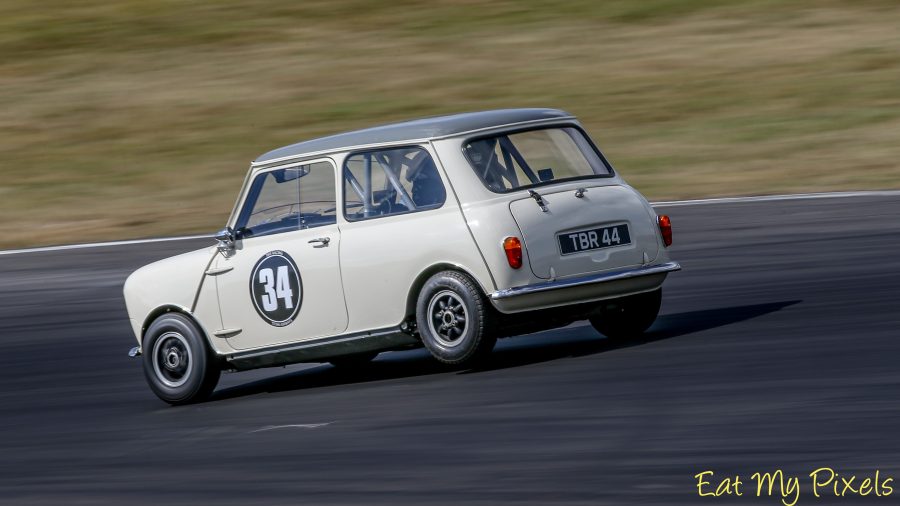
Sadly, the Pre-‘66s’ final race began with a big pile-up which caused a lot of expensive damage that nobody wants to see. As Shovlin charged around the outside of Paddock Hill Bend his Cortina was sent into a spin and the chain reaction involved at least a dozen cars. Ten of them, mostly from the upper/mid pack, ended up stuck in the gravel, almost all heavily damaged.
The race was red-flagged and restarted over a slightly shorter distance with a much depleted field. Tordoff easily completed his quartet of victories, with Victor Cullen and Grange completing the podium.
Thompson got the better of Michael Cullen for fourth with a switchback manoeuvre exiting Clearways. Swann and Sime were next, ahead of the Mini of John Davies, who for once didn’t have to start at the back of the grid, having taken over from brother Mike for the whole of the second day. Adrian Oliver (Hillman Imp) won Class E in ninth overall, with Mark Uka (Mini) completing the top 10.
James Ibbotson had extended his 2025 Class E winning streak to 10 races before his Imp was caught up in the big accident. Brian Bedford’s Austin A40 was another casualty, having won Class D in races one and three. Luc Wilson’s similar car was the beneficiary in race four having also triumphed in the second contest.
Pre-’83 Group 1 Touring Cars
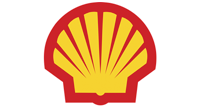
The Shell Oils Pre-’83 Touring Cars ran alongside the Pre-’93, Pre-’03 and Group A machinery on the Grand Prix circuit before having standalone races on the Indy layout on Sunday. Ford Capri-mounted BTCC star Charles Rainford took both GP circuit races before Jonathan Corker’s Datsun 510 claimed the honours on the Indy.
Corker had set the pace in qualifying, ahead of the Ford Escort Mk1s of regular rival Nic Grindrod and Tom Harvey, with Rainford only fourth fastest in the busy session.
Rainford quickly moved ahead in the first race, with Grindrod also jumping Corker. In a bizarre incident, Grindrod’s rear windscreen became dislodged and managed to damage the Datsun’s front screen as it escaped. Both managed to continue with Corker moving into second and putting the pressure on Rainford.
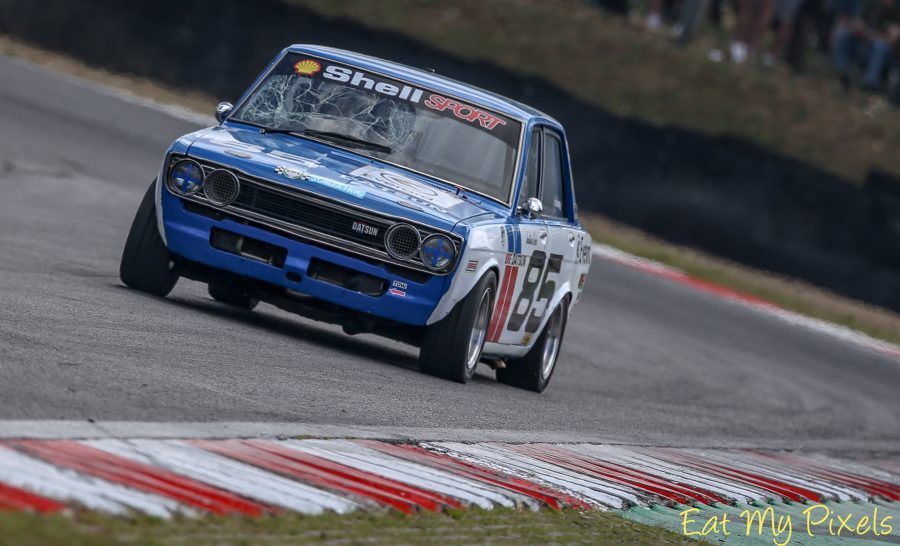
With the Capri running in pure Group 1 spec (as opposed to Group 1.5 allowed in the regulations), Corker took advantage of the Datsun’s superior braking ability to dive ahead at Druids hairpin. But a mistake which caused him to run wide at Surtees allowed Rainford to come back past and repeat his success at this event last year. Corker, of course, still won Class C.
Grindrod was third but engine problems meant that was his last action for the weekend. The same went for Harvey, who having held off Smith for fourth by just 0.3s, was unable to cure a worrying oil leak. Nick Williamson’s Class B Rover SD1 was sixth, ahead of Chris Snowdon (Alfa Romeo Alfetta GT) and Neil Philpotts (Mitsubishi Lancer Turbo).
With the damage to his windscreen, Corker had to remove both front and rear screen for the second race – good for cooling in the searing heat, but less good for drag at high speed. Rainford was able to take a slightly more comfortable win.
Corker was second again and Smith third, chased by Williamson’s Rover, which had taken some rear-end damage earlier on. Philpotts and Snowdon improved to fifth and sixth.
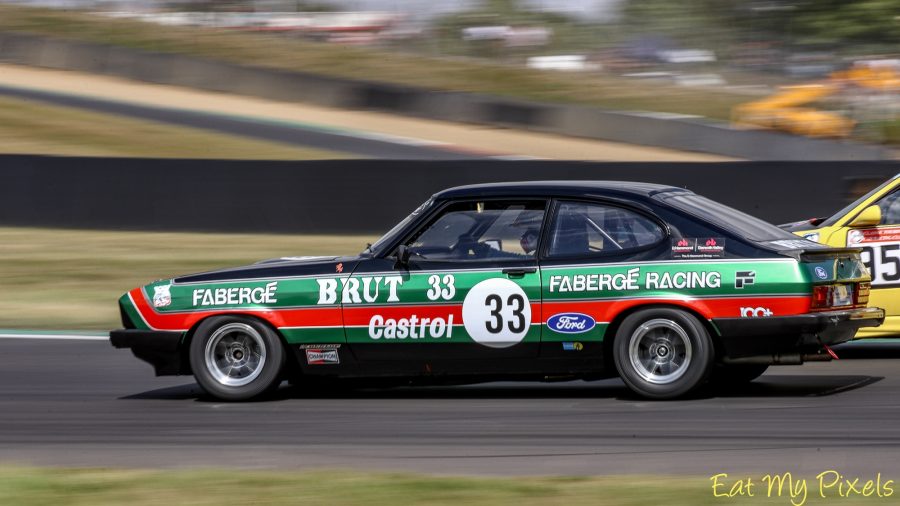
On a much quieter track, Rainford took Indy circuit pole by nearly half a second from Corker. Williamson managed third and there was an impressive showing by Jared Roe’s Mk2 Escort ahead of George Osborne (in for Snowdon) and Smith.
The top two pulled clear in the race as Corker kept the pressure on Rainford. He made his move around the outside soon after half-distance, then pulled clear for victory as temperatures took their toll on the slowing Capri.
Rainford explained he could also hear a knocking from the rear of Faberge machine and, though he finished second, he sat out the finale after confirming it was a recurrence of a loose wheel issue he’d experienced before.
The battle that raged for third between Williamson, Smith and Osborne – finishing in that order – might have been for second with a lap or two more. Knight was sixth ahead of Philpotts and Mostyn Rutter, who joined the field for day two in his Vauxhall Firenza.
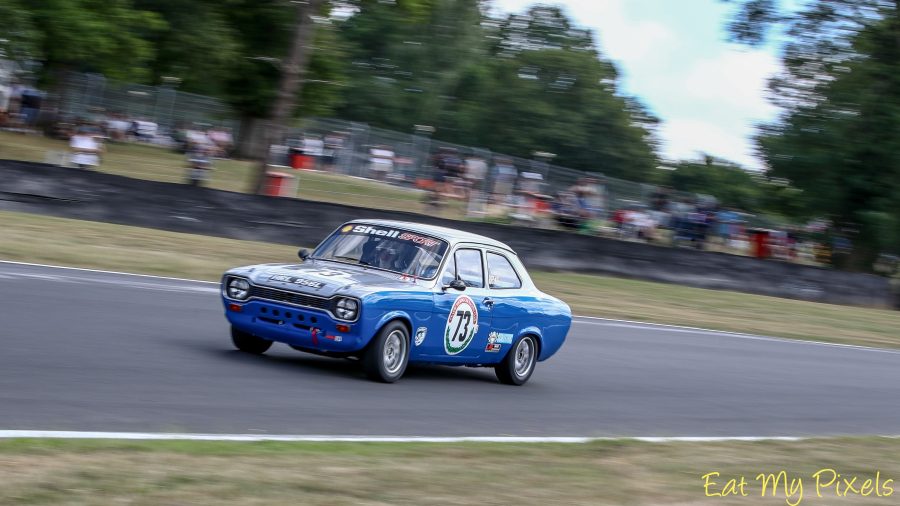
With no Rainford to worry about, Corker concluded the weekend with a comfortable win, the championship leader’s sixth of the season. Williamson was having to manage his tyres more than the lighter Escorts but still wound up second, despite a 10s penalty for jumping the start.
The penalty would have dropped the Rover behind Osborne, but the Alfa driver was penalised for contact at Druids when he passed Smith in the closing stages. The Escort limped home in what became sixth, with Osborne penalised to seventh.
Ahead of them, Philpotts completed the podium, finishing second to Williamson in Class B, with Rutter fourth – also second in class – and Knight fifth, despite slowing as the Escort burnt its last dregs of fuel.
Class D welcomed a new car in the shape of former Pre-’66 man Robyn Slater’s 1600cc Mk1 Escort. Driving it in anger for the first time in Saturday qualifying, Slater went on to beat Phil Waller’s Chrysler Sunbeam to class honours in all four races.
Full results are available via the TSL website.
All images courtesy of CTCRC official photographer Steve Jackman/Eat My Pixels
